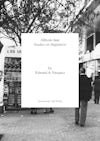
Yayoi Kusama: Infinity Mirror Room – Phalli’s Field
ByJo Applin
In this first monograph on Infinity Mirror Room — Phalli’s Field (1965), Jo Applin examines the importance of this epoch-defining work in the context of Yayoi Kusama’s ‘obsessional art’.
Content
Almost a half-century after Yayoi Kusama first exhibited her landmark installation Infinity Mirror Room — Phalli’s Field (1965) in New York, the work remains challenging and unclassifiable. Shifting between Pop-like and Surreal, Minimal and metaphorical, figurative and abstract, psychotic and erotic, it seems to embody what the 1960s were about, while at the same time rejecting the prevailing aesthetics of its time. Lined with mirrors and carpeted with hundreds of polka-dotted fabric protrusions that Kusama called ‘a sublime, miraculous field of phalluses’, the installation succeeded in completely absorbing the viewer into an parallel world.
In this first monograph on an epoch-defining work, Jo Applin examines its ongoing importance in the context of Kusama’s ‘obsessional art’ and discusses its relationship to contemporary theory and the practice of artists such as Lee Lozano, Louise Bourgeois and Eva Hesse, involving environments, ‘eccentric abstraction’, play, sexuality and softness.
Purchase or preview
This publication can be purchased or previewed using the following markets.



